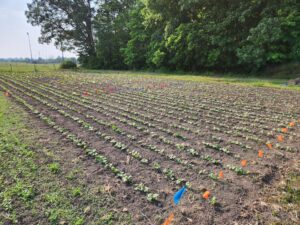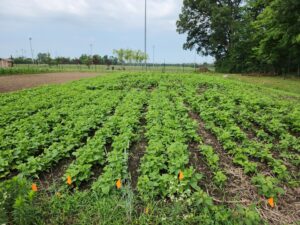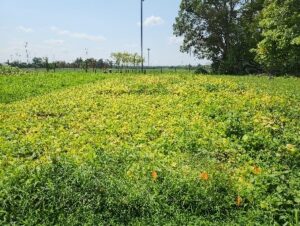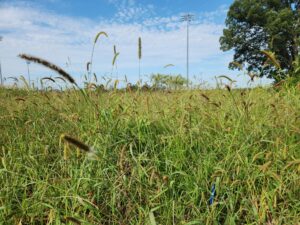The 2023 dry edible bean harvest wrapped up in mid-September. This season was unique from a weather standpoint – dry in June and wet in July, rather than the other way around. How did this affect the trial?
Dry beans are a short-season crop, especially compared to many of the field crops we are used to in Indiana (Figures 1, 2 and 3). While many varieties of field corn and soybeans take more than 100 days to mature, dry edible beans may be ready in as few as 80 days. The varieties chosen for the trial in 2022 and 2023 mature, on average, in about 85 days. Student workers kept the field well-weeded until canopy closure, aided by dry conditions that slowed some weeds down in June. Students and researcher both favored a Johnny’s wheel hoe and various Rogue hoes for this plot. But with a wet July that kept the soil moist and with leaf drop beginning in early August, weeds were raring to go. Foxtails abound in this plot (Figure 4)!
Foxtails perpetrate extensive yield loss and harvest difficulty in dry edible beans. Adapted to no- and low-till conditions, foxtail seeds germinate readily when disturbed within the top inch or so of soil and can produce seed in as few as 40 days. Their ideal growing conditions roughly match most summer annual crops. As few as 2 plants per 6 feet of row can reduce yields by 6%1. As you can see above, there were a few more than 2 plants per 6 feet of row in this plot. Speaking from personal experience, foxtails make hand-harvesting beans difficult. Beans and foxtail stems intertwine and make finding dried-down bean plants a challenging scavenger hunt. Some varieties of beans are particularly prone to lodging, so the scavenger hunt challenge intensifies when seeking them out through clumps of foxtails. Hidatsa Red beans lodged the worst of all varieties this year, laying almost completely flat on the ground when mature.
Other weeds popped up in the trial as well. Species include Eastern black nightshade, pokeweed, Amaranthus, horsenettle, and a variety of other grasses.
What’s an organic bean grower to do? Choose fields with good drainage2 and the least weed pressure, particularly from foxtails and other grasses. Try a variety of cultivation techniques that pair well with your soil and tool selection. But also prepare for increased weed pressure – this crop’s lack of competitiveness will likely dose the seedbank with problem weeds for future seasons. Originally, I took on this project to see if dry beans could help diversify crop rotations and product portfolios while allowing for an early cover crop seeding. This year, however, it is obvious that dry edible beans are not an ideal choice under certain growing conditions and in weedier fields.
Resources
1. Integrated Weed Management in Dry Edible Beans by Brenda Waters and Don Morishita, PNW545, University of Idaho, 2001.
2. Dry Bean Production Guide, A1133-20, North Dakota State University Extension, 2019.



